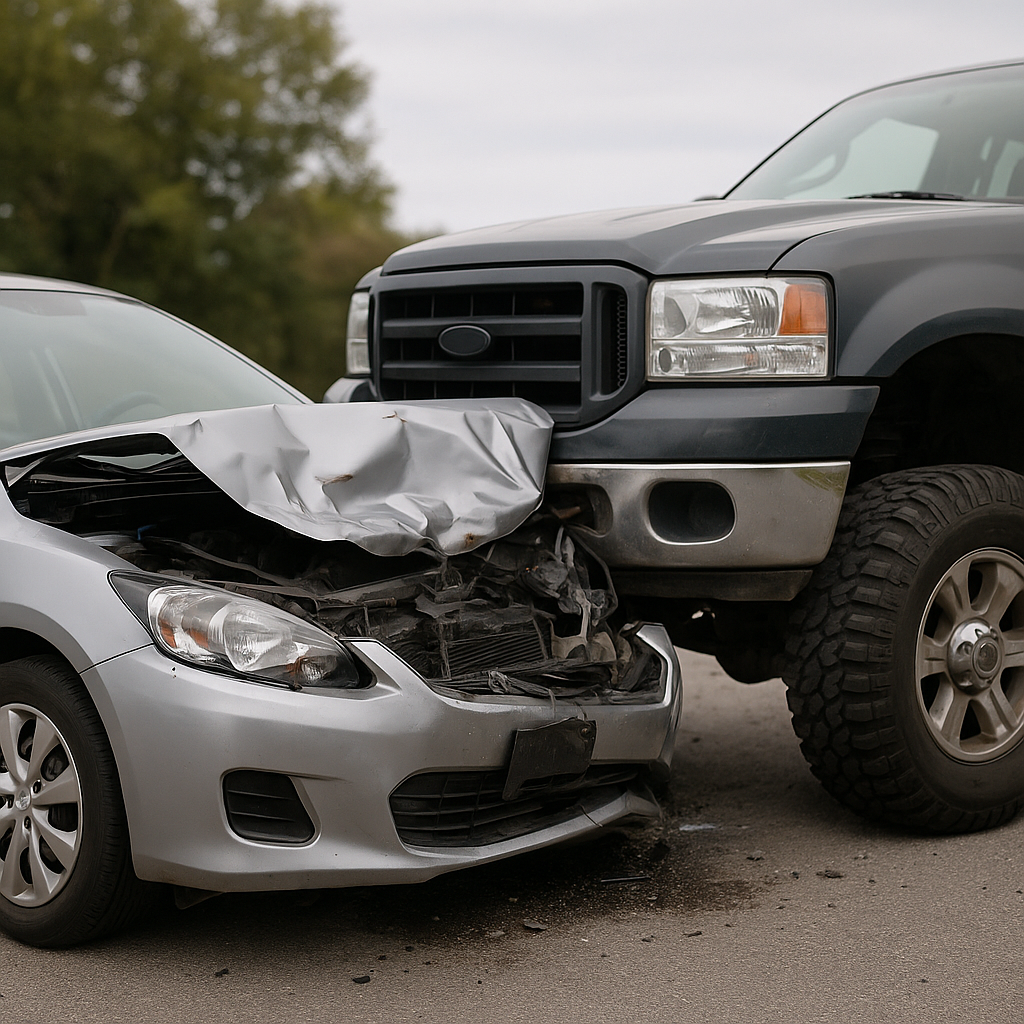How Vehicle Size and Weight Contribute to Auto Accident Injuries
On behalf of Harper, Evans, Hilbrenner & Netemeyer

In 2022, over 42,000 people died in motor vehicle crashes in the U.S., according to the National Safety Council. The Insurance Institute for Highway Safety (IIHS) reports that drivers of smaller cars are twice as likely to be killed in a collision than those in larger, heavier vehicles.
This matters. A lot.
Vehicle weight in a car accident isn’t a minor factor. It’s a major one. It influences injury severity, vehicle damage, medical costs, and even legal fault.
If you’ve ever driven a compact car beside a lifted pickup on a Missouri highway, you know how different those vehicles feel.
One is built for protection. The other? Built for efficiency. And when they collide, the difference in outcomes is dramatic.
Here’s how vehicle size and weight affect crash outcomes, and what that means for your recovery and legal options after a serious accident.
What is the Relationship of Vehicle Weight to Force of Impact in a Collision?
It’s simple physics: Force = mass × acceleration.
When a heavier vehicle crashes into a lighter one, the mass difference multiplies the force exerted on the smaller vehicle. That force transfers directly into the frame, cabin, and ultimately, your body.
Imagine a 6,000-lb truck and a 2,800-lb sedan both moving at 35 mph. In a frontal crash, the lighter car will experience more sudden deceleration and greater structural deformation. The heavier vehicle keeps moving longer, transferring more energy into the smaller car.
That’s why vehicle weight in a car accident is often linked to the severity of injury. The heavier the vehicle, the more energy it delivers during the collision, and the greater the danger to the other driver.
Why Size and Weight Matter in Car Accidents
When two vehicles crash, the heavier one delivers more force. This is Newton’s Second Law in action. And in crashes, more force means more trauma, especially to occupants in the smaller vehicle.
Heavier vehicles:
- Are less affected by the impact of lighter ones
- Transfer more kinetic energy to other vehicles
- Crush smaller vehicles more easily
If you're in a 2,800-lb sedan and you’re hit by a 5,500-lb SUV, your car absorbs the majority of the energy. Your risk of serious injury goes up, whether you were at fault or not.
Stat Check:
- IIHS data shows minicars have a death rate over 80% higher than large SUVs in frontal crashes.
- The average full-size pickup weighs 5,000 to 6,000 lbs. Compact cars hover around 2,500 to 3,000 lbs.
The result? In any mismatch, smaller vehicles lose more than sheet metal. They lose the ability to protect their occupants effectively.
Injuries Are Worse When Heavier Vehicles Are Involved
The weight and height of large vehicles make injuries more severe in the vehicles they strike. Heavier vehicles also tend to ride higher, so their impact often bypasses the bumper and crumple zones designed to absorb energy.
That leads to:
- Head and chest trauma from cabin intrusion
- Spinal cord injuries from blunt force impacts
- Broken bones from structural collapse
- Long-term or permanent disabilities
These aren’t just more likely, they’re more expensive to treat and more disruptive to your life. Victims often need long-term care, adaptive equipment, and extended recovery.
In Missouri, the average hospital cost for a serious injury crash was over $25,000, according to MoDOT. That doesn't include lost wages, follow-up care, or the cost of permanent disability.
Missouri Roads and Crash Trends
Missouri roads carry risk, especially for drivers of smaller vehicles.
The Missouri Department of Transportation (MoDOT) reported 1,040 fatalities in 2023, with rural highways accounting for most. Trucks and SUVs make up a growing percentage of traffic in both rural and suburban areas.
Pickup trucks are particularly common across Boone, Callaway, and Audrain counties. Their elevated height and weight make them more dangerous to other road users. Most rural collisions involve high speeds, longer braking distances, and limited shoulder room. This all worsens outcomes for anyone not in a heavy vehicle.
In cities like Columbia and Jefferson City, SUVs dominate intersections and parking lots. That increases the danger to cyclists, motorcyclists, and compact car drivers who are harder to see and more vulnerable to crash forces.
Are Bigger Vehicles Safer for Their Drivers?
For drivers inside them, yes.
Heavier, taller vehicles offer more protection for their own occupants. They have stronger frames, higher seating, and more mass to absorb crash energy. The trade-off? More danger for everyone else.
Drivers of trucks and SUVs:
- Face less injury risk themselves
- Are more likely to cause serious harm in multi-vehicle crashes
- Often don’t feel the impact as intensely, leading to underreporting of crash force
Also, they have:
- Longer stopping distances
- Wider turning radii
- Larger blind spots
These features increase the risk of hitting pedestrians and cyclists, who already face high injury rates. In fact, pedestrian fatalities in the U.S. rose 13% in 2021, largely due to more crashes involving SUVs and trucks (source: Governors Highway Safety Association).
Is It Safe To Drive a Small Car?
Smaller cars can be safe, but the context matters.
Modern small vehicles now come with advanced crash mitigation tech:
- Automatic emergency braking
- Lane departure warnings
- Crumple zones designed to absorb frontal impact
But physics still works against them. Even the best-designed small car can’t overcome the basic disadvantage in a collision with a heavier SUV or truck. If you're mostly driving in urban environments, small cars can be very safe. But on highways or rural roads, especially in Missouri, where large trucks are common, you’re at higher risk.
That’s why choosing a safe small car involves more than just its crash rating. Consider where and how you drive. And remember, vehicle weight in a car accident is one of the strongest predictors of injury outcome.
Who’s Liable When Weight Plays a Role?
Missouri uses a comparative fault system. That means each party in a crash can be assigned a percentage of blame. Your damages are reduced by your share of fault. But here’s the key: the force of impact, and who delivered it, can influence how fault is interpreted.
Example: A 6,000-lb SUV rear-ends a 2,700-lb compact car at 35 mph. The compact driver suffers spinal injuries and the car is totaled. Even if the SUV driver claims they “barely tapped the other car,” physics tells a different story.
In cases like this, an experienced attorney will examine crash reconstruction data, vehicle specifications, and medical reports to show how the heavier vehicle contributed to the severity of the injuries. The weight difference becomes a critical factor in proving the extent of damages.
What You Should Do After a Crash With a Larger Vehicle
- Get medical help right away. Even if you feel okay. Internal injuries often appear hours later.
- Photograph the scene. Get wide shots showing vehicle sizes, damage levels, and surrounding conditions.
- Get a police report. Make sure it lists vehicle weights or models, which can be used later.
- Talk to a personal injury lawyer early. Don’t let insurers steer the narrative. These cases often involve major injury claims and aggressive defense tactics.
Also: Don’t downplay what happened. If you were in a smaller car and hit by a larger one, your recovery will likely be harder. That deserves to be reflected in your legal claim.
Why Legal Help Matters in Heavy Vehicle Cases
Heavy vehicle crashes bring heavy resistance. Insurance companies know these claims get expensive fast. They may try to:
- Minimize the role of vehicle size
- Suggest your injuries were “pre-existing”
- Offer fast settlements to limit payouts
You need someone who understands how vehicle dynamics influence injury claims.
Harper, Evans, Hilbrenner & Netemeyer has been representing injured drivers across Missouri for years. We’ve handled cases involving trucks, SUVs, commercial vans, and other heavy vehicles. We know how to build a case that shows the real impact of vehicle weight on your injuries.
We don’t settle for less. We investigate, reconstruct, and advocate. We make the facts speak for you.
Final Thoughts
Vehicle weight in a car accident changes everything. It determines how hard you’re hit, how badly you’re hurt, and how long your recovery takes.
If you’ve been in a crash with a heavier vehicle, you may be facing injuries that weren’t your fault—but you’re left to deal with the consequences. Don’t face that alone.
Contact Harper, Evans, Hilbrenner & Netemeyer for a free consultation. Let’s talk about what happened, what your injuries mean, and what your next step should be. We’ll handle the legal side so you can focus on getting better.

